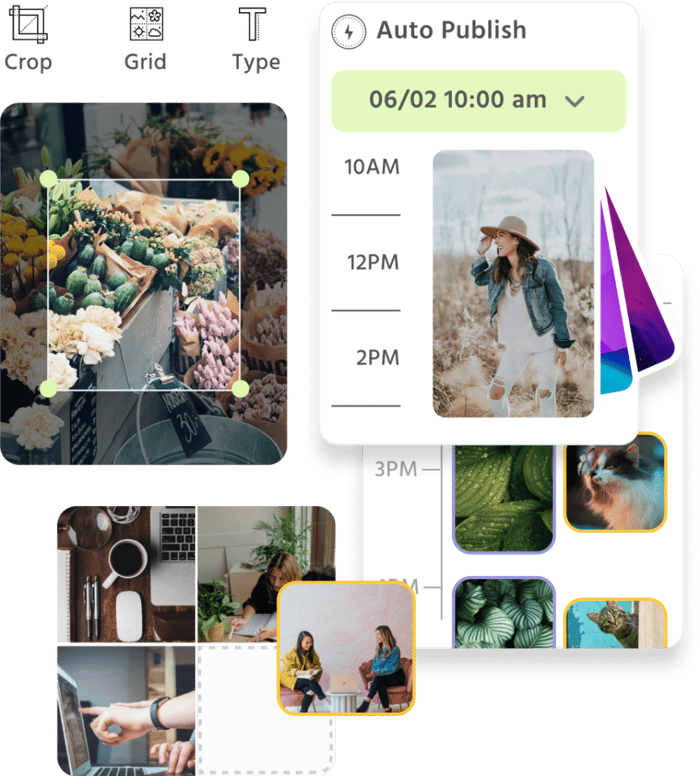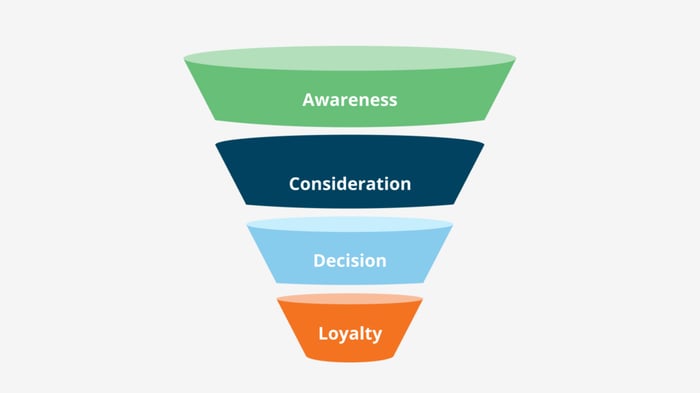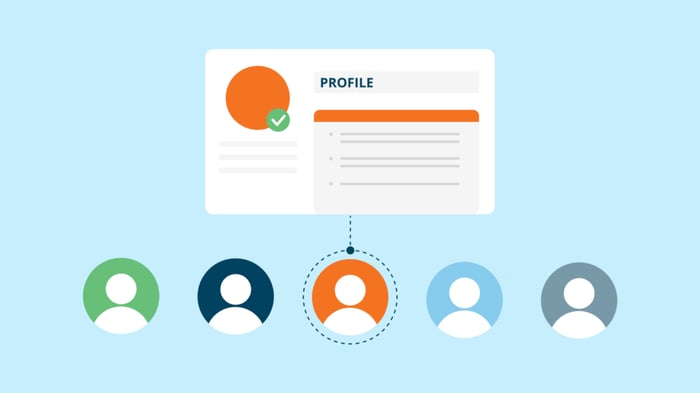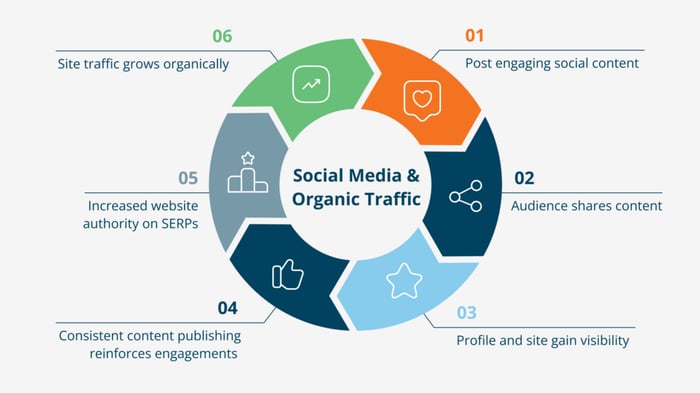Marketers may assume the investment in social media marketing is too great with too little return. It requires commitment, consistency, patience, and data-driven iteration. But with the right solution, you can make social media an essential part of your inbound marketing strategy.
In this article, we’ll discuss what inbound marketing is, the role of social media in inbound marketing, why it’s important, and key tips to leverage it to your advantage.

Manage all your social media accounts in one place.
Craft, schedule, & auto-post content to all your social channels, then track analytics and manage interactions from a single, easy-to-use dashboard.
What is inbound marketing?
Inbound marketing is a way of increasing traffic to your brand site organically. By “organically,” we mean without paid ads, catching the attention of consumers likely to be interested in your brand already. This is unlike outbound marketing, which tries to pull in as many cold leads as possible via external channels (i.e., channels that don’t belong to your brand).
Generally, when we think of inbound marketing, we think of website content, blog posts, lead magnets on landing pages, and so on. What also goes into that inbound content is social media. In fact, you could consider your social media marketing plan to be a part of your overall inbound marketing strategy.
Is social media marketing considered inbound marketing?
Social media is one entry point for organic traffic for your brand’s main platform. That makes unpaid social media marketing an important, inextricable part of inbound marketing.
Social media is very flexible — you can use it to reach interested potential customers at every step of the buyer journey.
- Awareness stage: You can attract consumers looking for a solution to a problem they may or may not know. Do this with social posts targeting relevant topics and hashtags that will interest the audience. Social media is also a place to share educational, entertaining, and relatable content that is tailored to your target audience. The key is adding value — not making a sale.
- Consideration stage: Once invited into your audience, they consider your brand a practical option but may not be ready to commit. This is where you can use your content to nurture your audience through videos, stories, and guides that help them see the value of your brand..
- Decision stage: During this stage, consumers are more familiar with your brand and about to make a decision. Your job is to give them that final push. To do this, publish content like product comparisons, product demos, testimonials, and product reviews.
- Loyalty stage: Finally, the consumer becomes a customer, and social media keeps them connected with you and fellow customers. The goal is to keep them engaged and inspire more purchases. The right content at this stage includes product updates, customer newsletters, promotions, and loyalty rewards.
Organic social media is a powerful tool to making that first touch point. Plus, it brings a level of authenticity that ads can never achieve, as the algorithm shows your brand content to those who are the most likely to be interested.

Top 7 reasons social media is an important part of inbound marketing
Social media attracts more organic traffic. Let’s go over the reasons why:
1. Builds brand awareness
Social media is one of the first places users look when researching a brand. 22% of users discover brands via social media comments and recommendations. Meanwhile, between 25% and 28% of users across different age groups actively use social media to find products to buy. That means you’re missing a huge chunk of potential consumers if you’re not regularly posting on social media.
Most users search Google for specific answers and may come across your website if its message matches their intent. However, more users use social media to gauge a brand’s authority. In fact, Google research revealed that 40% of young people go to TikTok or Instagram when they’re looking for a brand or product.
Consumers often research brands on social media to see what other people are saying about them.
2. Enables access to different target audiences
If your only inbound marketing strategy is website and blog content, you’re missing out on so many opportunities to reach your target audience. It’s helpful to develop personas, hyper-specific profiles of your desired customers, in order to learn how to best engage your target market.
If you know what social media platforms your audience/personas frequent, you should be targeting those platforms. Once you do, you must cater to them with psychology-driven social media content.
Pro-tip: On a micro-level, notice what content formats align with your personas. For example, certain personas may engage with casual Instagram stories, while others prefer educational graphics.
On a macro level, pay attention to the culture of each social media platform and how it aligns with different personas. For example, TikTok will reach an entirely different persona than LinkedIn.
Loomly helps manage different audiences with a social media calendar that includes all your platforms.

3. Promotes audience engagement
Engagement is king on social media, and it starts with quality content. Quality content leads to increased engagement, which directly affects reach. The more your audience engages, the more people will see your content.
Second, the way you respond to comments and interactions matters, because people are always watching! Users who research your brand may be interested in how you communicate and interact with your customers.
Pro tip: One of the best ways to boost engagement is to create a community. Social media makes it easier to create a more direct community around your existing followers and customers. Your brand is more immediately accessible, something that blog content or email lists can’t accomplish. One simple way to do this is to listen to your audience and interact with them in the name of a greater mission, like promoting mental health or encouraging users to help fundraise for a cause.
4. Encourages two-way communication
Encouraging communication with customers and users increases engagement and opens the doors to questions or suggestions (about your product, service, mission, etc.).
Questions provide fuel for more content that directly gives your audience what they need. Suggestions provide inspiration for improvement. This two-way communication gives you enough content material to last months, as well as ideas to make a more customer-loving brand.
Pro-tip: One way to establish two-way communication is to invite user-generated content (UGC) by asking users to share photos. For example, Depop’s social media marketing campaign is simple: they publish featured product images of their users/sellers on the app. Or take Calvin Klein, which invites users to post pictures of their products with the hashtag #MyCalvins.
5. Increases Social SEO
When you publish content, users who view, engage, and share your content to your content create more social media traffic. Your community grows, leading to increased social media interactions, which can drive more traffic to your website. Creating engaging content that is specific to your niche will increase your SEO on individual social media platforms, but that content can also show up in Google searches as well.
Pro-tip: Use a mix of well-known and specific keywords to build relevant SEO-driven hashtags — 3-5 main hashtags are suitable. To pick effective keywords, most social media platforms will have a tags section in the search feature, which shows the top related keywords.
Alternatively, social analytics show your top posts, so you can reverse-engineer what keywords you used that made it so successful. For instance, Instagram Insights can inform you about posts with the most impressions and how many views came from the hashtags you used.

6. Inspires content creation ideas
Social media keeps you up to date on industry trends, as well as cultural trends circling in the spaces your target audience frequents.
Keeping up with trends increases the likelihood of sharing and establishing a connection with the audience. They get a sense of your business being “in” with the crowd or understanding them on a deeper level.
Famous ice cream brand Ben & Jerry’s used the popular astrology trend to inspire this Reel in which they matched flavors to signs. In the caption, they encouraged engagement by asking users to share their signs.
Pro tip: Plan content in advance, but mix in relevant trends as they pop up. When you batch create evergreen brand content in advance, that frees up time to hop on trends before they become outdated. Loomly makes it easy to plan, schedule, and rearrange your social media content calendar as needed.
7. Offers a high ROI
Remember when we said users look to social media for new buys? The statistics show that investing in social media leads to actual conversions. A good 55% of users aged 16-24 have purchased after seeing a brand on TikTok. Based on self-report, 85% of Gen Z consumers say social media influences their buying decisions.
Pro-tip: The ROI for organic social media is less intuitive than the ROI for ads, but it’s still important to calculate. Tracking metrics like engagement rate, reach, follower conversion, and link clicks are helpful to gain an in depth understanding of the value of organic social media!
Practical Tips for Social Media Challenges
Building a social media presence can take a lot of work. However, it pays dividends in the form of a sense of authority and visibility. Here’s some practical advice for dealing with the challenges that come with social media:
Tip one: Create high-value content (lead magnets) that show authority, such as:
- Informative posts
- Free ebooks
- Podcasts
- How-to’s
- Webinars
Tip two: Understand your audience’s preferences, interests, and pain points. That way, you’re sure your social media content will resonate with your audience and foster meaningful engagement.
Tip three: Stay informed about trends. Trends are constantly changing, and so are social media algorithms. Stay up-to-date with the latest trends and adjust your strategy accordingly.
Tip four: Consistency is of utmost importance regarding social media. Maintain a regular posting schedule to ensure your audience is regularly engaged and informed.
Conclusion
Social media isn’t just an important part of an inbound marketing strategy. The two are practically inseparable. Considering how often consumers are on social media and use it for most of their buying decisions, its advantages are clear.
The main thing to focus on is creating content that engages your target audience, and track the results. With Loomly’s social media management platform, you can plan posts, auto-schedule stories or videos, manage your online community, and track metrics.
Try Loomly’s 15-day free trial today to unlock organic traffic via social media.



